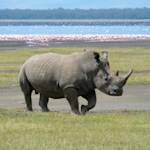Arabian leopard
2022 CE • Arabian Peninsula
The critically endangered Arabian leopard populations have "shrunk by as much as 90 per cent since the beginning of the 19th century, and officially there are less than 200 left in the wild, with the largest single population – around 50 adults – in Oman . . . Now the equivalent of a ghost, [the Arabian leopard has been] pushed into the remotest mountainous areas, so that it almost never crosses paths with any humans. Even if some individuals do still exist, the population is slowly disappearing . . . As with many large carnivores around the world, the presence of domestic animals – and the associated absence of wild prey – led to leopards changing their behaviour and targeting, in this case, goats, sheep and young camels. Local pastoralists came to view them as a threat to their way of life and resorted to revenge killings. In Saudi Arabia, poison-laced bait was once the favoured method . . . Rock traps were also commonly used, but were replaced by metal cages baited with goat meat. Add in hunting of the prey species, leading to further declines, sport hunting of the leopards themselves, and some evidence of trade in both leopard body parts and live animals in the 1980s, 1990s and early 2000s, and – despite the huge, open spaces that are their natural habitat – it leaves these big cats little room for manoeuvre . . . The Arabian leopard probably isn’t the world’s rarest big cat, but it is one of a number that are so threatened they now require highly targeted interventions to stop them from becoming extinct."
"Born to be wild: A daring vision of the Arabian leopard’s future," The Independent, September 29, 2022.
Image: Land Rover Our Planet via Flickr, Attribution-NoDerivs 2.0 Generic (CC BY-ND 2.0)


Learn about Maya Lin’s fifth and final memorial: a multi-platform science based artwork that presents an ecological history of our world - past, present, and future.

Discover ecological histories and stories of former abundance, loss, and recovery on the map of memory.

Learn how we can reduce our emissions and protect and restore species and habitats – around the world.

See how art can help us rethink the problems we face, and give us hope that each one of us can make a difference.

Help make a global memorial something personal and close to home. Share your stories of the natural world.


